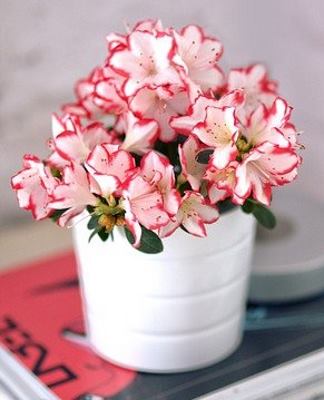Azalea Bushes: How to Care For Flowering Azalea Shrubs (including Pruning and Growing in Pots)

Azalea bushes are spectacular flowering shrubs with eye-catching blooms in a wide range of colors and shapes. Brightly colored azalea flowers are funnel-shaped and come in shades of pink, red, orange, white, yellow, and purple. Flowering azalea bushes are easy to grow in a garden landscape and add plenty of color as they bloom from late winter until early fall.
Azalea bushes have a range of uses in a garden landscape. Their shrub-like growth and rounded shape are ideal for planting along borders, as background plantings, ground cover, or foundation plantings. With the proper pruning, you can train the shrub to grow as a small azalea tree. Azalea bushes grow well in containers on a patio, deck, or a large room with plenty of natural light.
This article is a comprehensive guide to growing azalea bushes in your front or backyard. In addition to handy tips, you will get helpful information on the best types of azalea flowers for your garden.
How to Care for Flowering Azalea Bushes
To grow azalea shrubs in your yard, plant the bushes in full sun or partial shade in well-drained soil. Water the flowering bushes weekly and add a layer of mulch to ensure adequate soil moisture. Add organic compost in spring to provide nutrients. Prune azaleas just after blooming in spring.
About Azalea Bushes

Azalea bushes include many varieties with various sizes and flower colors
Azaleas are a group of showy flowering shrubs in the genus Rhododendron. There are over 10,000 azalea cultivars that come in all different shapes and colors. Native azaleas from North America are from the Rhododendron subsection Pentanthera. Some types of azaleas are winter hardy, and others need semi-tropical climates to thrive.
There is such a wide variety of azaleas that there is a type for almost every landscape. Most azaleas thrive in well-drained, acidic soil and are slow-growing shrubs. Azaleas can be dwarf shrubs, growing 1 to 3 ft. (0.3 – 1 m) tall. Other large azalea bushes can grow between 8 and 15 ft. (2.4 – 4.5 m) tall.
Many cities worldwide, including many in the US, have azalea festivals in spring to celebrate the beauty of azalea flowers.
To find suitable varieties of landscaping azaleas for your area, it’s essential to check the hardiness zone. For example, some cold-hardy perennial azaleas thrive in USDA zones 3 or 4 up to zone 8. On the other hand, some azaleas are from the tropics of Southeast Asia and thrive in Florida, Texas, and South Carolina.
Are Azalea Bushes Evergreen or Deciduous?
Azalea bushes can be evergreen or deciduous shrubs. Typically, native North American varieties are deciduous azaleas. These hardy shrubs lose leaves in the winter and come back in the spring. Asian varieties are usually evergreen azaleas that are smaller than deciduous ones, and keep their leafy foliage throughout the year.
Azalea vs. Rhododendron — The Difference Between Azaleas and Rhododendrons
Azaleas are often confused with rhododendron bushes because they look similar. While azaleas are in the genus Rhododendron, they are small to medium-sized shrubs with tubular or funnel-shaped flowers. On the other hand, rhododendron flowers are larger, bell-shaped blooms, and the leaves are thicker and leathery.
One subtle difference between azalea blooms and rhododendron flowers is that trumpet-shaped flowers on azalea bushes have five anthers, not ten.
What is an Azalea Tree?
An azalea tree is a standard azalea shrub trained to grow as a tree. All azaleas have shrub-like growth with multiple spreading stems. Growing an azalea tree requires proper pruning. However, with the correct technique, you can grow a single-stemmed azalea tree with a rounded crown, beautiful flowers, and compact foliage.
To grow an azalea tree, trim all the stems emerging from the ground, leaving between one and three of the healthiest ones. Next, remove the horizontal branches growing within 4 ft. (1.2 m) of the soil surface. Finally, to maintain your azalea tree, remove emerging shoots every spring.
Azalea Flowers

Azalea flowers can be single, semi-double or double blooms
Flowers growing on azalea bushes are identified as trumpet-shaped fragrant flowers with five petals joined at the base. Azalea blooms usually have five anthers emerging from the center. Azalea flowers come in many forms, from single flowers to showy semi-double or double flowers with flat, ruffled, frilly, or twisted petals.
Azalea flowers can range in size from 0.25” (6 mm) across to 5” (12 cm). The color patterns on showy azalea flowers can be a single color or have stripes, blotches, polka dots, or bright-colored petals with contrasting margins.
Typically, azaleas bloom in spring. Depending on the species, azalea shrubs may already produce flowers as early as February. However, most azalea shrubs bloom around April or May. The spectacular azalea spring flowers last for around three weeks. Some azalea varieties bloom again in summer and persist until the fall.
Types of Azaleas
Whatever your climate or garden landscape, there is a variety of azalea that will suit your yard. Here are examples of some azaleas:
- Deciduous azalea shrubs—The hardiest azalea plants will withstand freezing temperatures, have stunning showy flowers, and grow 4 to 5 ft. (1.2 – 1.5 m) tall.
- Evergreen azalea bushes—Only reliable in zone 6 and above, evergreen azaleas are suitable for southern gardens and tend to be smaller than the deciduous varieties.
- Low-growing azaleas for ground cover—Some azaleas have a short height of around 12” (30 cm) and a wide spread, suitable for ground cover, foundation plantings, or colorful borders.
- Tall azaleas—The tallest azaleas can grow around 15 ft. (4.5 m) tall and can fill a large space with spectacular colors.
- Late-blooming azaleas—To extend the blooming season of azaleas, grow flowering azaleas that produce flowers in mid- to late-summer.
- Weeping azaleas—The popular ‘Pink Cascade’ is a weeping azalea with evergreen foliage, drooping cascading branches, and stunning pink flowers.
Related reading: Stunning types of azaleas.
When to Plant Azalea
The best time to plant azaleas outdoors is in the fall. Planting flowering shrubs before the dormant season gives the roots time to establish themselves. The shrubby plants will be ready to start blooming the following spring. Alternatively, you can plant azaleas in spring if you care well for them during summer.
Where to Plant Azalea Bushes
Flowering azalea shrubs grow best in moist, acidic soil, full sun to partial shade, and some protection from the wind. Evergreen azalea plants perform best in partial shade. However, hardy deciduous azalea plants bloom profusely in full sun.
When choosing the ideal location to plant an azalea bush, choosing the right soil type is crucial. Azaleas thrive in acidic soil that drains well yet holds enough moisture. If you have alkaline soil, you should amend it with peat moss, acidifying nitrogen, leaf mold, or plenty of organic compost or mulch.
In clay soils, you will also need to work in plenty of organic matter to improve its structure and nutrient content.
It is also a good idea to avoid planting an azalea plant where there is poor drainage. Waterlogged soil leads to root rot, poor blooming, and your once stunning bush will eventually die. To avoid soggy soil, you could mix in loamy topsoil or sandy soil or grow the azalea in a raised bed.
Another consideration when deciding on where to plant an azalea bush is sunlight. Avoid planting the sun-loving plant in heavy shade. In hot, sunny climates, azaleas or rhododendrons can benefit from afternoon shade. But they require around six hours of sunlight daily to produce plenty of blooms.
How to Plant Azalea Outdoors
After choosing the ideal location to plant an azalea, you should prepare the ground for planting. Dig a hole that is larger than the shrub’s container or root-ball but not deeper. Combine compost in the extracted soil to create an acidic environment for planting in the ground.
Plant the azalea so that the root ball is 2” (5 cm) higher than the soil surface. Then, backfill the hole with the soil and compost mix. When filling in the hole, press down to remove all air pockets. Lastly, thoroughly water the newly-planted azalea to hydrate the roots.
How far apart to plant azalea shrubs outdoors? The answer about spacing azaleas depends on your landscape idea. For example, to plant azaleas as a flowering hedgerow, plant the shrubs 3 feet (1 m) apart. On the other hand, if you want a more open landscape, space azaleas between 3 and 5 feet (1 – 1.5 m) apart. However, remember that azaleas will grow as wide as they are tall.
How to Care for Outdoor Azaleas
Watering is a critical care aspect when growing azalea bushes in your garden. Azaleas are shallow-rooted plants and need regular watering to keep the soil moist. You may need to water azaleas once or twice a week, depending on the climate. However, it’s vital to avoid watering so much that the soil becomes waterlogged.
Because azaleas have a shallow root system, keeping the ground moist can be an issue. Therefore, an important way to care for an azalea outdoors is to add a layer of mulch.
Adding a 3” to 4” (7.5 – 10 cm) layer of organic mulch can help lock in moisture. This will also ensure adequate soil temperature in cold weather. Appropriate types of azalea mulch include shredded leaves, straw, pine needles, and pine bark.
How To Plant Azalea in Pots

Potted azalea shrubs
Azalea bushes grow well in pots and containers, making them ideal for container gardens, patios, entrance-ways, or deck areas. To grow azaleas in containers, you should plant them in a loose soil mix specifically for acid-loving plants. You can also combine equal parts of potting soil and pine bark.
Grow the potted azalea at the same height as the nursery pot, leaving about 2” (5 cm) free between the soil surface and pot rim.
To water a potted azalea shrub, pour water until it drains from the pot’s drainage hole. Because azaleas prefer moist soil that is never soggy, only water the plant when the top 1” to 2” (2.5 – 5 cm) of soil is dry.
How to Grow Azalea Indoors

Potted azalea indoors
Growing azalea plants in pots is ideal if you want to grow them indoors. The container for an azalea plant should contain slightly acid soil that drains well. For example, you could use peat-based soil that is amended with perlite for better drainage.
A potted azalea plant growing indoors needs plenty of indirect sunlight. Too much direct sunlight could result in brown flowers and scorched leaves. However, it’s best to check the specific azalea variety as some thrive in direct sunlight.
An azalea indoors thrives in cool to warm temperatures and moderate humidity. Ideally, keep room temperature between 60°F and 70°F (16°C – 21°C) and at least 50 percent humidity. If the air is too dry, you can put the plant pot on a pebble tray with water to increase humidity.
Here are some handy tips for growing a small azalea plant indoors:
- Allow the plant to go dormant in winter by putting it in a place where the temperature is between 40°F and 55°F (4°C – 13°C)
- Prune the stems back after flowering to leave about 0.25” (0.6 cm) from the main stem
- Prune stems at a 45° angle
How to Prune Azalea Shrubs
Pruning azaleas is a way to keep the beautiful bushes blooming year after year and encourage bushy growth. The best time to cut back azaleas is in spring or summer after they have finished blooming. This way, you avoid chopping off the flower buds that will bloom the following year.
The type of pruning azaleas requires depends on your landscaping requirements. Typically, azaleas look best with minimal pruning. Azaleas are suited to a natural, informal look. So, cut back any branches that look out of place. Thinning azalea shrubs by removing leggy branches allows more air to circulate.
If the bush has grown too big, you can “head” the azalea plant. This means cutting back azaleas to around 12” (30 cm) above ground level. Do this in spring before new growth appears. This allows next year’s flower buds to start developing in July. Then when new shoots are 6” to 12” (15 – 30 cm) long, cut the tips off to encourage healthy branching.
How to Transplant Azalea Bushes
Transplanting an azalea shrub in spring is sometimes necessary if you need to change its location. Alternatively, suppose you bought a rooted azalea bush from a garden center. In that case, you’ll need to transplant it to an appropriate place in the garden.
Before digging up the existing plant, prepare the new location. The location should have dappled sunlight or full sun, slightly acidic soil, and excellent drainage. Prepare the site by digging a hole 24” (60 cm) wide and 12” (30 cm) deep.
The next step is to dig around the azalea main stem about a 12” (30 cm) radius and 12” (30 cm) deep. Azaleas have shallow root systems; however, they recover well after transplanting.
Next, gently ease the root ball from the ground and move it to the new hole immediately. Plant the shrub at the same depth as before. Then, backfill the hole, pressing firmly to support the azalea bush. Water thoroughly. And then water with 1” (2.5 cm) of water every week until the plant becomes established.
How to Propagate Azalea Shrubs

The easiest way to propagate azalea shrubs is by stem cuttings
Using stem cuttings is the easiest way to propagate an azalea shrub. Take five or six stem cuttings after flowering at the end of spring by cutting just below a node. The semi-hardwood cuttings should be 6” to 12” (15 – 30 cm) long and flexible without snapping.
Then remove the leaves from the lower part of the stem and scrape off some of the outer bark from the lower 2” (5 cm) of the stem. Next, dip in rooting hormone and then put the stem cutting into a moist potting mix. This should contain equal parts of compost, peat moss, and sand.
Then place the potted cutting in a sheltered spot with bright sunlight. Roots take between four and eight weeks to develop. During this time, keep the soil moist but not soggy. Keep growing in the container until the following spring. To protect the azalea cuttings during winter, put a layer of organic mulch over the soil surface.
Azalea Problems and Diseases
Azaleas flowers and foliage are generally hardy and free of pests and diseases. However, common garden pests such as caterpillars, lace bugs, rhododendron borers, whiteflies, and bark scale can affect azaleas.
Some ways of getting rid of bugs and destructive insects from azalea bushes include using a neem oil spray, natural Bacillus thuringiensis (Bt) spray, or insecticidal soap.
Incorrect watering techniques or poor air circulation can result in fungal or bacterial foliage infections. For example, soggy soil can lead to phytophthora root rot, resulting in wilting, poor growth, and withered leaves.
To resolve issues with root rot, it’s vital to find the infected roots and remove them. Sometimes, only part of the azalea bush has yellowing leaves and other signs of rotting roots
Poor air circulation can result in powdery mildew — a white substance on the leaves. If mildew is an issue, use a milk spray to improve the plant’s appearance. Thinning the branches can help to enhance airflow through the branches. Additionally, when watering, avoid splashing water on the leaves.
Additionally, too much sun and too little soil moisture can result in brown or yellow spots on the leaves.
Related articles:
